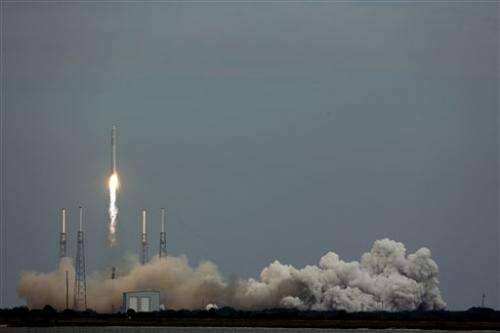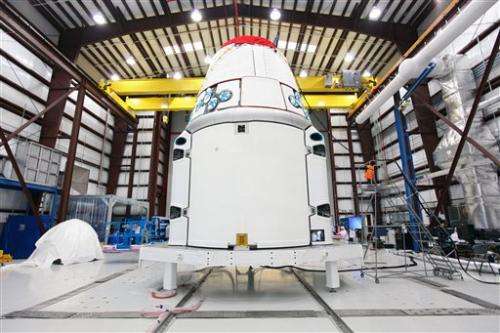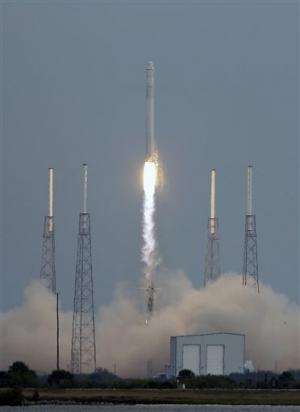SpaceX rocket launched, but problem with thrusters (Update 3)

A commercial vessel carrying a ton of supplies for the International Space Station ran into trouble shortly after liftoff Friday.
SpaceX's billionaire founder Elon Musk reported a problem with the thrusters on the unmanned spacecraft, named Dragon. Three of the four sets of thrusters did not kick in, he said via Twitter, and flight controllers for the company were trying to override the system.
Read an update: SpaceX working to fix Dragon capsule's thrusters
Musk said from SpaceX Mission Control in California that he wants at least two thruster pods active before the twin solar panels that provide power are deployed.
U.S. space agency flight controllers in Houston offered help as they monitored space station operations.
The problem cropped up immediately following Dragon's separation from the rocket upper stage, nine minutes into the flight. The launch itself appeared to go flawlessly.
More than 1 ton of space station supplies is aboard the Dragon, including some much-needed equipment for air purifiers. The capsule is supposed to arrive at the space station Saturday morning.
This is the first major trouble to strike a Dragon in orbit. Two previous capsules, launched last year, had no problem getting to the space station.
SpaceX has a billion-dollar contract with NASA to restock the orbiting lab, and hopes the venture will lead to astronaut rides in a few years.

The private company, run by the billionaire who helped create PayPal, launched its unmanned Falcon rocket into clouds right on time. It was the third supply run by a Dragon capsule, an unparalleled accomplishment all under a year.
Launch controllers applauded and gave high-fives to one another, once the spacecraft safely reached orbit. The successful separation of the Dragon from the rocket was broadcast live on NASA TV; on-board cameras provided the unique views nine minutes into the flight.
Then the trouble struck.
The space station and its six-man crew were orbiting 250 miles (402 kilometers) above the Atlantic when the Falcon soared. Astronauts are to use a hefty robot arm to draw the Dragon in and dock it to the station.
SpaceX tucked fresh fruit into the Dragon for the station residents. Also on board: 640 seeds of a flowering weed used for research, mouse stems cells, protein crystals, astronaut meals and clothing, trash bags, air-purifying devices, computer parts and other gear.
SpaceX—formally Space Exploration Technologies Corp.—has a $1.6 billion contract with NASA for space station shipments.
NASA's deputy administrator, Lori Garver, said using commercial providers is more efficient for the space agency. It's part of a long-term program, she noted, that has NASA spending less money on low-Earth orbit and investing more in deep-space missions. That's one reason why the space shuttles were retired in 2011 after the station was completed.

The goal is to have SpaceX and other private firms take over the job of ferrying astronauts to and from the space station in the next few years.
SpaceX—so far the leader of the pack—is aiming for a manned Dragon flight by 2015.
This is the second in a planned series of 12 SpaceX deliveries under the contract with NASA; the first was last October. A company-sponsored demo mission kicked everything off last May.
Russia, Japan and Europe regularly make station deliveries as well, and Russia is the only option for astronaut rides. But only the Dragon is designed to bring back substantial amounts of research and used merchandise.
This Dragon is scheduled to spend more than three weeks at the space station before being cut loose by the crew on March 25. It will parachute into the Pacific with more than a ton of medical samples, plant and cell specimens, Japanese fish and old machinery, and used spacewalking gloves and other items.
SpaceX plans to launch its next Dragon to the station later this year.
Copyright 2013 The Associated Press. All rights reserved. This material may not be published, broadcast, rewritten or redistributed.


















